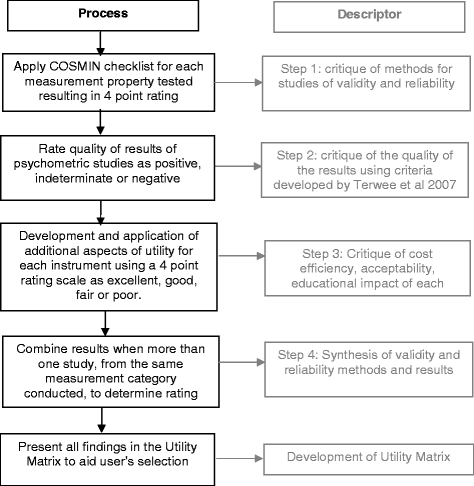Instruments to measure patient experience of healthcare quality in hospitals: a systematic review
- PMID: 26202326
- PMCID: PMC4511995
- DOI: 10.1186/s13643-015-0089-0
Instruments to measure patient experience of healthcare quality in hospitals: a systematic review
Abstract
Background: Improving and sustaining the quality of hospital care is an international challenge. Patient experience data can be used to target improvement and research. However, the use of patient experience data has been hindered by confusion over multiple instruments (questionnaires) with unknown psychometric testing and utility.
Methods: We conducted a systematic review and utility critique of questionnaires to measure patient experience of healthcare quality in hospitals. Databases (Medical Literature Analysis and Retrieval System (MEDLINE), Cumulative Index to Nursing and Allied Health Literature (CINAHL), Psychological Information (PsychINFO) and Web of Knowledge until end of November 2013) and grey literature were scrutinised. Inclusion criteria were applied to all records with a 10 % sample independently checked. Critique included (1) application of COSMIN checklists to assess the quality of each psychometric study, (2) critique of psychometric results of each study using Terwee et al. criteria and (3) development and critique of additional aspects of utility for each instrument. Two independent reviewers completed each critique. Synthesis included combining findings in a utility matrix.
Results: We obtained 1157 records. Of these, 26 papers measuring patient experience of hospital quality of care were identified examining 11 international instruments. We found evidence of extensive theoretical/development work. The quality of methods and results was variable but mostly of a high standard. Additional aspects of utility found that (1) cost efficiency was mostly poor, due to the resource necessary to obtain reliable samples; (2) acceptability of most instruments was good and (3) educational impact was variable, with evidence on the ease of use, for approximately half of the questionnaires.
Conclusions: Selecting the right patient experience instrument depends on a balanced consideration of aspects of utility, aided by the matrix. Data required for high stakes purposes requires a high degree of reliability and validity, while those used for quality improvement may tolerate lower levels of reliability in favour of other aspects of utility (educational impact, cost and acceptability).
Systematic review registration: PROSPERO CRD42013006754.
Figures
References
-
- Agency for Healthcare Research and Quality. HCAHPS Fact Sheet CAHPS Hospital Survey. USA; 2012.
-
- Agency for Healthcare Research and Quality. HCAHPS Survey 2012. [http://www.hcahpsonline.org/Files/HCAHPS%20V7%200%20Appendix%20A1%20-%20...]. - PubMed
-
- Beattie M, Shepherd A, Howieson B. Do the Institute of Medicines’ (IOM) dimensions of quality capture the current meaning of quality in health care?—an integrative review. J Res Nurs. 2012;18:288–304. doi: 10.1177/1744987112440568. - DOI
Publication types
MeSH terms
LinkOut - more resources
Full Text Sources
Other Literature Sources
Medical



